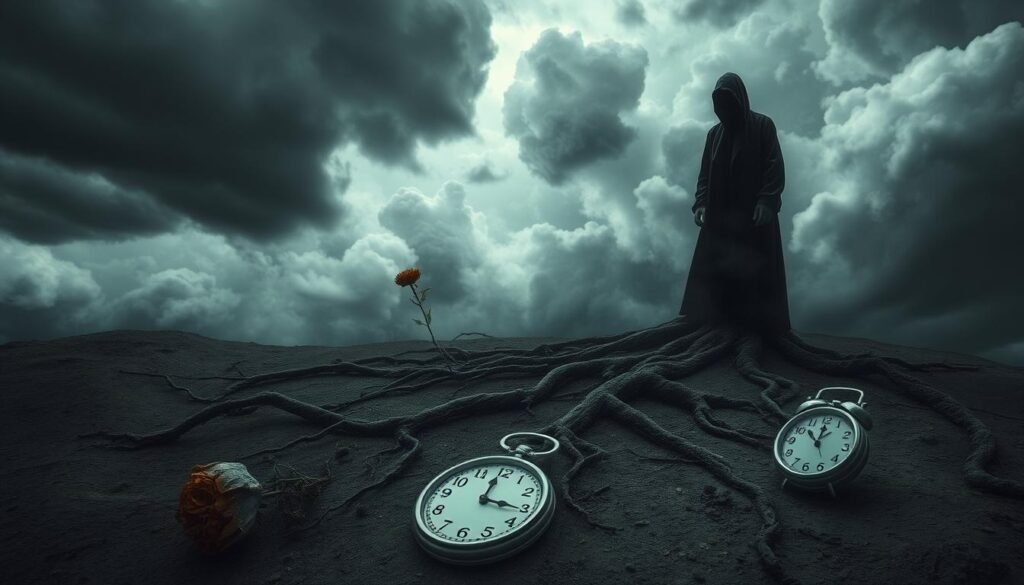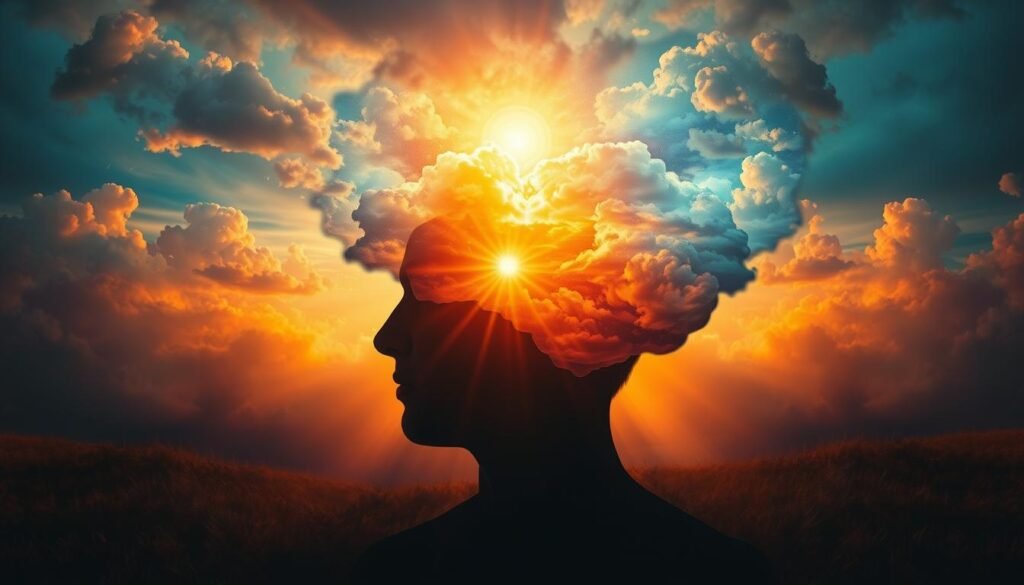About 20% of people with depression show signs different from usual depression. This kind, called atypical depression, has unique signs like mood shifts and too much sleep. Knowing about it is vital for proper diagnosis and treatment, as it often starts before 20 and lasts longer.
Key Takeaways
- Atypical depression comprises about 20% of depressive episodes.
- It features unique symptoms not typically seen in traditional depression.
- This subtype often has a higher prevalence in women compared to men.
- Effective treatment options include psychotherapy and medication.
- Understanding atypical depression can significantly improve quality of life.
- Early intervention is critical, as symptoms often begin in adolescence.
What Is Atypical Depression?
Atypical depression is a subtype of major depressive disorder with unique symptoms. It often makes diagnosis difficult. People with this condition see their mood improve after positive events, thanks to mood reactivity. What Is Atypical Depression also means having two of these symptoms: increased appetite or weight gain, sleeping a lot, feeling weighed down, or being overly sensitive to rejection.
Finding out if someone has atypical depression is hard because the symptoms vary a lot. Around 18% to 36% of people with depression have these unusual features. It usually starts before someone turns 20 and is more common in women. Also, people with bipolar disorder and seasonal affective disorder often have atypical depression.
Despite depression’s stigma, it’s crucial to get professional help for atypical depression. Treatments like cognitive-behavioral therapy (CBT), interpersonal therapy (IPT), and certain medications are effective. Psychiatrists and therapists are key in helping individuals recover and better their mental health.
Atypical Depression Definition
Atypical depression is a type of major depressive disorder. It stands out because of certain unique features. People with it react differently to mood changes.
They often sleep more and eat more. They are also very sensitive to being rejected. Understanding what Atypical Depression is helps in seeing these special characteristics.
It usually starts early, often in the teen years or young adulthood. Being chronic, it affects people for a long time. Knowing about Atypical Depression helps experts give better care.
About 40% of those with major depression have atypical features. It’s more common in women, by four times. These facts show why special treatments are necessary.
| Statistic | Details |
|---|---|
| Prevalence Rate | Approximately 40% among major depressive disorder patients |
| Gender Ratio | Four times more common in females |
| Typical Onset Age | Often in adolescence or early 20s |
| Chronic Nature | Many describe symptoms present since childhood |
Symptoms of Atypical Depression
Atypical depression is a complex type of depression. Knowing its symptoms is vital for awareness and treatment. People with this depression show different emotional and physical traits unlike other depressions.
Common Symptoms
Common symptoms of atypical depression include:
- Heightened emotional responses to positive events
- Increased appetite leading to overeating
- Excessive sleeping, beyond typical sleep patterns
- Leaden paralysis, describing a heavy feeling in the limbs
- Strong sensitivity to rejection, affecting personal and professional relationships
Many patients with atypical features share these symptoms. For instance, about 71% report feeling highly sensitive to rejection. This fact is key for diagnosing and grasping the nature of atypical depression.
How Symptoms Differ from Other Types of Depression
Atypical depression stands out from other kinds mainly in mood reactivity. Unlike melancholic depression, which has constant sadness and insomnia, atypical depression lets people feel better after happy moments. This distinct trait helps doctors spot differences in depressive disorders.
To diagnose atypical depression, patients must show at least two other symptoms. This shows it’s biologically different from other depressions, which means treatments need to be specific.
Recognizing the common symptoms and their unique aspects is crucial. It helps create effective, personalized treatment plans.
Atypical Depression Causes
The causes of atypical depression are complex. They include both biological and environmental factors. Knowing these causes is crucial for effective treatment.
Biological Factors
Biological factors have a big part in atypical depression. Imbalances in neurotransmitters like serotonin, dopamine, and norepinephrine influence mood. This can impact mental health significantly. If mood disorders run in the family, the risk of atypical depression increases. Such depression tends to start early in life, studies suggest.
Environmental Influences
Environment plays a big role in atypical depression too. Events like losing someone important or constant arguing can trigger it. Stress and guilt can make it worse. This shows how key a supportive environment is for managing depression.

| Causal Factors | Impact |
|---|---|
| Neurotransmitter Imbalance | Plays a crucial role in mood regulation. |
| Genetic Predisposition | Higher risk with a family history of mood disorders. |
| Life Events | Stress from major events can trigger episodes. |
| Interpersonal Conflicts | Ongoing conflicts may contribute to feelings of depression. |
| Environment Stability | A supportive environment mitigates risks of depression. |
Atypical Depression vs Major Depression
Atypical depression and major depression have similar symptoms but are quite different. Knowing the differences helps us understand each one better. It’s important for figuring out the type of depression someone has and how to treat it.
Comparing Key Features
Atypical depression differs from major depression mainly in how people’s moods can change. If you have atypical depression, your mood can get better when good things happen. But with major depression, sadness sticks around and does not get better with good news.
Signs of atypical depression include eating more or gaining weight, sleeping too much, not handling rejection well, and feeling mentally heavy. On the other hand, those with major depression might lose interest in fun activities, struggle to sleep or think about hurting themselves. This shows why it’s important to know the difference between Atypical Depression vs Major Depression for the right treatment.
Diagnosis and Treatment Differences
To diagnose atypical depression, you need two extra symptoms besides mood changes. For major depression, you need five out of nine specific symptoms. Treating these types of depression also varies. Atypical depression responds better to one kind of medicine, while major depression often needs another kind. This is why it’s key to know Diagnosis Differences for the best treatment approach.
Atypical Depression Diagnosis
To diagnose atypical depression, a qualified mental health professional will do a detailed evaluation. This Diagnosis Process checks if a person can feel better when good things happen. They also look for two other symptoms like eating more, sleeping a lot, or being very sensitive to rejection.
Doctors often do physical checks too. They want to make sure something else isn’t causing the depression signs. It’s key to know atypical depression is different because good news can lift the person’s mood.
Remember, atypical depression usually starts in the teen years. Early detection is super important. A correct Atypical Depression Diagnosis means getting the right help, like talking to a therapist, taking medicine, or seeing other experts. This way, treatment is made just for you.
If you are looking for more info, there are great resources out there. Learning about the Diagnosis Process can help you talk better with your doctor.

Treating Atypical Depression
To treat Atypical Depression well, doctors often use both medication and psychotherapy. They aim to meet each person’s unique needs. This helps make treatment more effective.
Psychotherapy Approaches
One top method for this kind of depression is Cognitive Behavioral Therapy (CBT). CBT helps people see and change negative thinking patterns. It teaches better ways to cope.
Interpersonal Therapy (IPT) is another good approach. It works on improving relationships and social skills. Mindful meditation also helps by lessening symptoms of depression.
Medications Used
When it comes to medicine, antidepressants are key in treating atypical depression. Selective serotonin reuptake inhibitors (SSRIs) are widely used. However, Monoamine Oxidase Inhibitors (MAOIs) might work better for some. Checking a patient’s reaction to these is crucial.
| Treatment Method | Description | Effectiveness |
|---|---|---|
| Cognitive Behavioral Therapy (CBT) | Focuses on changing negative thought patterns. | Highly effective for many individuals. |
| Interpersonal Therapy (IPT) | Enhances relationship skills and support systems. | Effective in improving social interactions. |
| Selective Serotonin Reuptake Inhibitors (SSRIs) | Helps balance serotonin levels in the brain. | Commonly used, effective for many. |
| Monoamine Oxidase Inhibitors (MAOIs) | May be more effective for atypical symptoms. | Used when other medications are ineffective. |
Making lifestyle changes is also helpful. More exercise and eating better can play a big part. A well-rounded approach is best for treating atypical depression. It improves mood and overall health.
Coping with Atypical Depression
Dealing with atypical depression means adopting strategies that truly help in everyday life. By caring for oneself and finding the right help, people can build a strong base to manage their symptoms.
Self-Care Strategies
Self-care is key for those managing atypical depression. Making healthy life choices can really improve mood and overall well-being. Exercise is great because it makes you feel better by releasing endorphins.
A diet full of nutrients keeps your energy and mood stable. Getting enough sleep is crucial too, as being tired makes depression worse. Trying mindfulness, like meditation or deep breathing, helps reduce stress and clear your mind.
Doing creative things, such as painting or writing, is a good way to express feelings. It helps you connect with your emotions. Keeping a journal can also be helpful. It allows you to track your mood and figure out what triggers your depression.
Seeking Support
Connecting with others plays a big part in healing. Getting support from friends or family offers a needed support system. Talking about what you’re going through can improve relationships. Support groups are helpful too because they provide a space to share experiences and learn.
Don’t forget about professional help in coping with atypical depression. Working with therapists or counselors gives you personal support. They help create coping strategies and understand your condition better. You can find helpful information and resources on WebMD.

Epidemiology of Atypical Depression
Atypical depression is a big health issue, affecting 15% to 36% of people with depression. These rates change based on the study method and group. About 18% to 36% of those with depression have atypical depression.
The start of atypical depression usually happens in the teen years or early adulthood. It lasts into the later years of life. A key point is that those with a BMI over 25 show more symptoms than those with a normal BMI.
Patients with bipolar disorder are more likely to have atypical depression than those with major depression or dysthymia. It’s critical to look at the different types of depression when studying its epidemiology of atypical depression.
Only 10% of people with atypical depression experience seasonal mood changes. This marks a difference from Seasonal Affective Disorder (SAD), showing they are distinct types of depression.
Atypical depression often occurs alongside anxiety, eating, and substance-related disorders. These comorbidities can affect how well treatment works.
Knowing more about atypical depression helps the mental health field do better. Paying more attention to how common it is can lead to more effective help and support.
| Study Cohort | Total Participants | Cases of Atypical Depression | Controls |
|---|---|---|---|
| CoLaus|PsyCoLaus | 3350 | 1461 | 1889 |
| NESDA|NTR | 4139 | 1182 | 2957 |
Conclusion
Atypical depression stands out as a unique kind of depression. It’s known for specific symptoms like mood changes and increased sleep or appetite. Spotting these signs is crucial for the right support and treatment.
Most of the time, atypical depression affects younger women. About 15-29% of those with Major Depressive Disorder have atypical features. It’s critical to see atypical depression as its own condition.
Boosting awareness about atypical depression helps improve care. Teaching both professionals and the public can lead to better health for those affected. For more details on atypical depression, check out the Atypical Depression Overview.